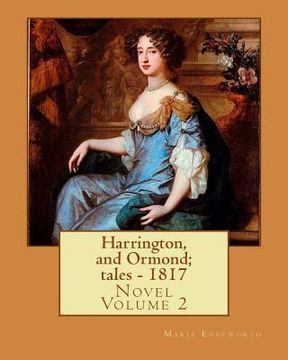Harrington, and Ormond; tales - 1817 (novel). By: Maria Edgeworth (Original Classics) VOLUME 2.: The novel is an autobiography of a "recovering anti-S
Reseña del libro "Harrington, and Ormond; tales - 1817 (novel). By: Maria Edgeworth (Original Classics) VOLUME 2.: The novel is an autobiography of a "recovering anti-S"
Harrington is an 1817 novel by British novelist Maria Edgeworth. The novel was written in response to a letter from a Jewish-American reader who complained about Edgeworth's stereotypically anti-semitic portrayals of Jews in Castle Rackrent (1800), Belinda (1801), The Absentee (1812), and her Moral Tales (1801) for children. The novel is an autobiography of a "recovering anti-Semite", whose youthful prejudices are undone by contact with various Jewish characters, particularly a young woman. It also makes parallels between the religious discrimination of the Jews and the Catholics in Ireland. Set between the Jewish Naturalization Act of 1753 and the Gordon Riots of 1780, the timeframe highlights these connections. Synopsis Harrington follows the protagonist of the same name who explores his memories to better understand his views on Jews. The novel begins with Harrington's early image of Jews, formed by stories told by his maid of Simon the Jew. Harrington says that the stories of Simon the Jew were " used upon every occasion to reduce me to passive obedience." His parents further strengthen this image by rewarding Harrington's antisemitism. Only after attending public school and meeting the bully Mowbray are Harrington's views on Jews changed. Mowbray's tormenting of the Jewish peddler Jacob causes this sudden shift in thinking. The story shifts to a romance novel with the introduction of Berenice Montenero, an American Jew who moved to England with her wealthy father. Harrington's family and friends are alarmed at his choice of a Jewish woman, a relationship further impeded by the advances of Harrington's old rival Mowbray. Seeking marriage into a wealthy family, Mowbray's attempts to court Berenice are denied. As revenge, Mowbray brings charges of insanity against Harrington, a situation further compounded by his family threatening to disown him. To marry Berenice, Harrington must overcome these obstacles and prove himself to Mr. Montenero. He is thus tested "by experiences designed to arouse his enthusiasm and fear."Mowbray is exposed as the culprit behind Harrington's supposed insanity and Harrington is deemed worthy of marriage to Berenice. This strange courtship is concluded with the revelation by Mr. Montenero, "I have tried you to the utmost, and am satisfied both of the steadiness of your principles and of the strength of your attachment to my daughter-Berenice is not a Jewess."... Maria Edgeworth (1 January 1768 - 22 May 1849) was a prolific Anglo-Irish writer of adults' and children's literature. She was one of the first realist writers in children's literature and was a significant figure in the evolution of the novel in Europe. She held advanced views, for a woman of her time, on estate management, politics and education, and corresponded with some of the leading literary and economic writers, including Sir Walter Scott and David Ricardo. Early life: Maria Edgeworth was born at Black Bourton, Oxfordshire. She was the second child of Richard Lovell Edgeworth (who eventually fathered 22 children by four wives) and Anna Maria Edgeworth; Maria was thus an aunt of Francis Ysidro Edgeworth. She spent her early years with her mother's family in England, until her mother's death when Maria was five. When her father married his second wife Honora Sneyd in 1773, she went with him to his estate, Edgeworthstown, in County Longford, Ireland. Maria was sent to Mrs. Lattafière's school in Derby after Honora fell ill in 1775. After Honora died in 1780 Maria's father married Honora's sister Elizabeth (then socially disapproved and legally forbidden from 1833 until the Deceased Wife's Sister's Marriage Act 1907)......

